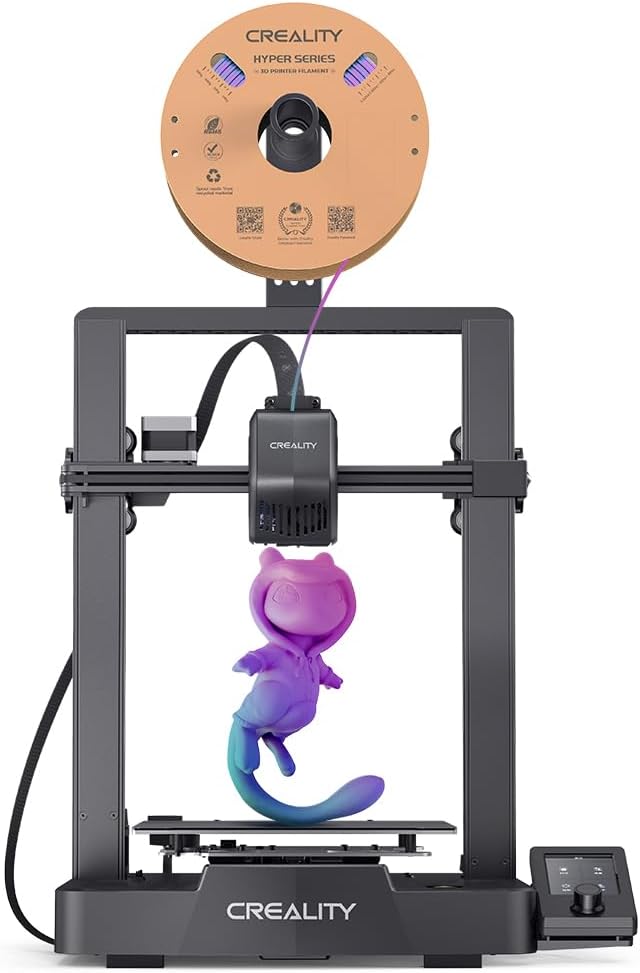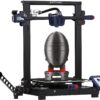The Creality Ender 3 V3 is one of the most popular entry-level 3D printers on the market, and for good reason. It offers a solid balance of affordability, ease of use, and decent print quality, making it a great choice for beginners and hobbyists alike. Let’s dive deep into its specs and features of one of the popular 3d printers to see where it shines and where it might fall short.
#1 Specs of Creality Ender 3 V3
The Creality Ender 3 V3, a hypothetical upgrade of the popular Ender 3 series, would likely build upon the strong foundation of its predecessors, incorporating enhancements and innovations to solidify its position as a leading budget 3D printer in the market. While there isn’t an official “Ender 3 V3” model as of my last update in December 2023, I’ll provide an overview of its specs based on, drawing on the evolution trends seen in previous versions like the Ender 3, Ender 3 Pro, and Ender 3 V2.
- Technology -Fused Deposition Modeling (FDM)
- Build Volume– 220 x 220 x 250 mm
- Max Nozzle Temperature – 260°C
- Heated Bed- Yes (up to 100°C)
- Auto Bed Leveling- Yes (CR-Touch sensor)
- Filament Compatibility- PLA, ABS, PETG, TPU (with some limitations)
- Print Speed- Up to 180 mm/s (recommended 60-100 mm/s)
- Connectivity– USB cable, MicroSD card slot
- Noise Level– < 50 dB
- Dimensions- 349 x 364 x 490 mm
- There is an optional “SE” version of the Ender 3 V3 that includes a Sprite direct drive extruder, which is better for printing flexible filaments, and a touchscreen display
- The Ender 3 V3 is constantly being updated and improved, so it’s important to check for the latest version and specifications before purchasing
- Weight– 8.5 kg
- Price– ~$250
#2 Build Volume and Frame
This is one of the best 3d printers and comes with a solid upgrade over its predecessor, offering improved reliability, ease of use, and print quality. While it might not be the most feature-rich option, its affordability and community support make it a great choice for those starting their 3D printing journey or looking for a reliable workhorse printer.
I) Build Volume
A competitive build volume is essential. The Ender 3 V3 might maintain or slightly increase the standard 220 x 220 x 250 mm build volume, providing ample space for a wide range of projects.
II) Frame Construction
The frame would likely continue to be made of aluminum, ensuring stability and durability. Any enhancements in frame design would aim to reduce vibrations and improve print quality.
#3 Printing Technology and Materials
I) Printing Technology
Fused Deposition Modeling (FDM) technology would be used, offering compatibility with a wide range of filaments.
II) Filament Compatibility
PLA, ABS, PETG, TPU, and more, with a 1.75 mm filament diameter. The machine could potentially include improvements to handle more exotic materials with greater ease.
#4 Extruder and Hotend
I) Extruder
An upgraded direct drive extruder could be featured for better filament handling and compatibility with flexible filaments. A high-performance hotend capable of reaching temperatures necessary for a variety of materials, potentially up to 260°C or higher.
#5 Heated Bed and Build Surface
I) Heated Bed
The inclusion of a rapidly heating bed, capable of reaching up to 100°C, would allow for better adhesion and compatibility with materials like ABS.
II) Build Surface
A carborundum glass platform, or an innovative new surface, could be included for excellent adhesion and a smooth bottom finish on prints.
#6 Precision and Speed
I) Layer Resolution
High resolution printing, with layer heights ranging from 0.1 mm to 0.4 mm, offering versatility between speed and detail.
II) Printing Speed
Optimized for speeds up to 180 mm/s, balancing fast printing with quality results.
#7 Connectivity and Interface
I) Connectivity
Wi-Fi and/or Bluetooth connectivity, in addition to SD card and USB, for easy remote operation and monitoring.
II) User Interface
An improved, larger color touchscreen interface for a more intuitive user experience, including real-time previews of print files.
Software and Firmware
III) Slicer Compatibility
Compatible with popular slicers like Cura, Simplify3D, and PrusaSlicer, offering users flexibility in software choice.
IV) Firmware
Open-source firmware, potentially Marlin-based, allowing for community-driven improvements and customizations.
#8 Safety and Noise Reduction
I) Safety Features
Thermal runaway protection, power loss recovery, and filament run-out sensor would be standard, enhancing the safety and reliability of long prints.
II) Noise Reduction
Stepper motor dampers or silent stepper drivers to ensure quieter operation, making it more suitable for home environments.
#9 Assembly and Calibration
I) Assembly
The Ender 3 V3 would likely continue the tradition of being semi-assembled, making it easy to set up within a few hours while providing an educational assembly experience.
II) Calibration
Improved auto-leveling capabilities, possibly including a BLTouch or similar sensor, for hassle-free bed leveling and optimal print adhesion.
#10 Price Point
I) Affordability
While incorporating these upgrades, the key to the Ender 3 series’ success has been its affordability. The Ender 3 V3 would aim to maintain a competitive price point while offering significant value through its enhancements.
#11 Features of Creality Ender 3 V3
- Removable Magnetic Build Plate – This makes it easy to remove prints and adheres well to most common filament types
- CR-Touch Auto Bed Leveling- This sensor automatically compensates for unevenness on the print bed, ensuring consistent first layer adhesion
- Silent Motherboard – The stepper motor drivers are quieter than previous models, making for a more pleasant printing experience
- Bowden Extruder -This type of extruder is simple and reliable, but may struggle with flexible filaments
- Dual Z-axis Lead Screws – These ensure better bed leveling and stability throughout the print
- Filament Runout Sensor – This optional add-on pauses the print if the filament runs out, preventing wasted material and failed prints
- Open-source Design – The Ender 3 V3 has a large and active community, providing access to numerous mods and upgrades
Here are some additional details:
- The hotend is made of aluminum, which is good for heat transfer but not as durable as copper
- The filament spool holder is basic and can be difficult to load/unload filament
- The included tools are basic and may not be sufficient for advanced tinkering
- The printer comes pre-assembled, but some calibration and adjustments might be needed for optimal performance
- The user interface is basic and might not be intuitive for beginners
- The community-provided firmware upgrades can offer additional features and performance improvements, but require some technical knowledge to install.

